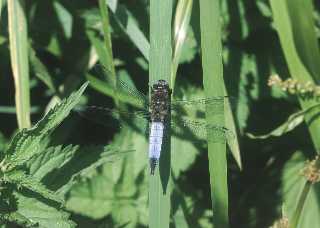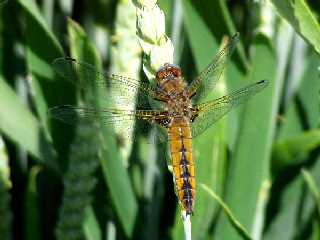

Worcestershire Record No. 17 November 2004 pp. 17-18
Mike Averill
|
|
|
| Scarce Chaser, Libellula fulva, male, photographed by the River Avon at Eckington 2004. Photo © Kevin McGee | Scarce Chaser, Libellula fulva, male, photographed by the River Avon at Eckington 2004. Photo © Mike Averill |
The Scarce Chaser Libellula fulva is classed as scarce in the Red data book of insects in Great Britain and Ireland being found in only 42 of all the 10 Km squares (1.33%). It was with some surprise that in 2004 this dragonfly was suddenly noticed and indeed was found to be very much at home in Worcestershire.
In Europe the distribution is widespread but local from France eastwards through Germany towards Russia. It is on the IUCN European species list of concern. Here in Britain the Scarce Chaser is restricted to ten scattered river systems in southern England yet it can be locally quite numerous. The six main localities are in Norfolk, Suffolk, Sussex, Cambridgeshire, Somerset, Avon, Dorset and Hampshire. Recently there have been signs of some expansion in to the River Wey on the Surrey/Hampshire border and the River Stour, Colne and Chelmer in Essex.
What is surprising is how many individuals were present in Worcestershire and the fact that they looked very established. While nationally the distribution in Britain of this dragonfly remains scarce, as of this year it stands as the 6th rarest in Worcestershire out of a total of 27 species.
How could this fairly obvious dragonfly be overlooked? It may well have been establishing itself for some years as there was in fact an unreported sighting of a specimen seen in 1998 at Strensham by Peter Garner. It was however a keen eyed fisherman who noticed its presence this year. Survey work this summer soon established that the dragonfly was easily seen along the River Avon from Pershore to Tewkesbury through Worcestershire and in to Gloucestershire. Finding the insect was not hard as it could be found in all the fishing bays, often with the similar looking Black-tailed Skimmer Orthetrum cancellatum. It is this species which could have led to the newcomer not being noticed as they are superficially similar. Telling them apart is not difficult as on closer examination the Scarce Chaser has a conspicuous dark triangle at the base of the hind wings unlike the Black-tailed Skimmer which has no such marking. Adult females are more distinguishable because they have an orange brown colour with black triangles on most abdominal segments. The males often exhibit the characteristic rubbing marks due to mating where the legs of females rub the blue pruinescence off the sides of the abdomen of the male. In terms of habit the familiar Black-tailed Skimmer is nearly always alighted on a wooded platform or flat bare earth, whereas the Scarce Chaser prefers to perch on vegetation.
The Scarce Chaser frequents slow flowing lowland rivers in nutrient rich water with prolific stands of Common Club Rush Schoenoplectus lacustris, Branched Bur-reed Sparganium erectum and Reed Sweet grass Glyceria maxima. The choice of smaller quieter streams means that the choice of the River Avon is not surprising. The discovery of this species certainly must make us view the Avon with increased interest and it cannot be dismissed just because the water quality has been poor in the past and because boats are present.
It will be interesting to see how this species fares in the future. Please be on the look out for larval cases, they are very distinctive in that they are libellulid in shape but have very prominent curved dorsal spines. The emergence period is mid May and the adult should be on the wing until mid July.
| The dots show the sites where Scarce Chaser, Libellula fulva, was recorded on the River Avon in 2004 |
| This map shows the records held nationally, shown in 10 km squares. This was copied from the NBN Gateway © Crown Copyright To access this yourself, click on the link: NBN Gateway L.fulva |
References
| MERRIT, R., MOORE, N. W., AND EVERSHAM B. C., 1996, Atlas of the dragonflies of Britain and Ireland, ITE Research Publication, No. 9. HMSO, London, pp. 94-95. | |
| British Dragonfly Society web site http://www.dragonflysoc.org.uk/ and management fact file. http://www.dragonflysoc.org.uk/mfflifulfull.htm | |
| The NBN gateway http://www.searchnbn.net | |
| SHIRT D. B., 1987, British Red Data Book: 2 Insects. Nature
Conservancy Council, Peterborough, pp. 402. |
| WBRC Home | Worcs Record Listing by Issue | Worcs Record Listing by Subject |